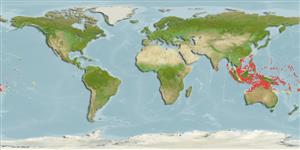Common names from other countries
>
Eupercaria/misc (Various families in series Eupercaria) >
Malacanthidae (Tilefishes)
Etymology: Hoplolatilus: Greek, hoplon = weapon + Latin, latus = wide (Ref. 45335).
Environment: milieu / climate zone / depth range / distribution range
Écologie
marin récifal; profondeur 18 - 100 m (Ref. 9710), usually 30 - 80 m (Ref. 27115). Tropical; 22°C - 28°C (Ref. 27115)
Indo-Pacific: Indonesia, Palau, Philippines, Papua New Guinea and Solomon Islands. Recently reported from Tonga (Ref. 53797).
Taille / Poids / Âge
Maturity: Lm ? range ? - ? cm
Max length : 12.0 cm TL mâle / non sexé; (Ref. 9710); common length : 10.4 cm SL mâle / non sexé; (Ref. 37816)
Épines dorsales (Total) : 9; Rayons mous dorsaux (Total) : 16; Épines anales: 1 - 2; Rayons mous anaux: 14 - 15; Vertèbres: 24. Preopercular serrae 27-44 (Ref. 9933).
Usually lives in very deep water adjacent to reef drop-offs (Ref. 48635); also on sandy and rubble areas (Ref. 9710). Builds large rubble mounts (Ref. 48635). Feeds on zooplankton. Solitary or in small groups (Ref 90102). Maximum depth reported taken from Ref. 128797.
Life cycle and mating behavior
Maturities | Reproduction | Spawnings | Egg(s) | Fecundities | Larves
Displays obligate monogamy where a one-to-one pair is established irrespective of resource abundance (Ref. 52884).
Burgess, W.E., 1978. Two new species of tilefishes (family Branchiostegidae) from the western Pacific. Trop. Fish Hobbyist 26 (#263, No. 5):43-47. (Ref. 9871)
Statut dans la liste rouge de l'IUCN (Ref. 130435)
CITES (Ref. 128078)
Not Evaluated
Menace pour l'homme
Harmless
Utilisations par l'homme
Pêcheries: commercial; Aquarium: Commercial
Outils
Articles particuliers
Télécharger en XML
Sources Internet
Estimates based on models
Preferred temperature (Ref.
115969): 23.7 - 28.3, mean 27 (based on 277 cells).
Phylogenetic diversity index (Ref.
82804): PD
50 = 0.5001 [Uniqueness, from 0.5 = low to 2.0 = high].
Bayesian length-weight: a=0.01122 (0.00514 - 0.02450), b=3.04 (2.87 - 3.21), in cm Total Length, based on all LWR estimates for this body shape (Ref.
93245).
Niveau trophique (Ref.
69278): 3.4 ±0.45 se; based on food items.
Fishing Vulnerability (Ref.
59153): Low vulnerability (10 of 100).
